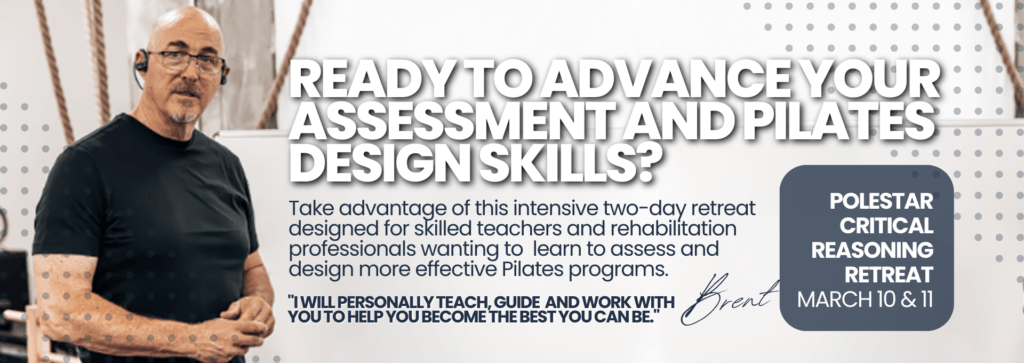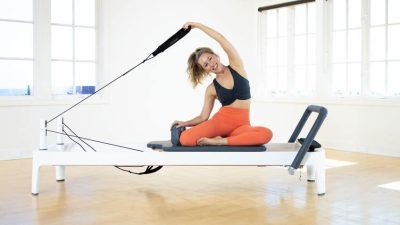
Brent Anderson and Shelly Power discuss the muscles that comprise “the core” – and it may be more muscles than you thought! Join us LIVE on Thursdays at 3 PM eastern to participate in the discussion in our #PilatesHour webinar. Watch #PilatesHour Episode 124 “Optimizing Cueing of The Core” Here.
BA: How do we think about cueing the core? For starters, the “core” muscles also include the muscles that connect the extremities to the core. I always say that “core control is the appropriate amount of stiffness for the anticipated movement”. Oftentimes in everyday activities, and in Pilates, the load to our core comes from our extremities. With the exception of putting weight directly on your chest, most core load comes from the extremities; head, arms, and legs.
We could then put a significant number of muscles into the category of “core control muscles”. Everything from the hip extensors, psoas muscles, hip abductors and adductors to pectoralis and latissimus muscles. All of these muscles are related to controlling and contributing to core control.
THE MYTH OF THE “CORE WORKOUT”
One thing we really want to debunk is the concept that core control is governed by the rectus abdominis. I get scared when someone says “I did a really hard core-workout”. In reality, all they did was work on the anterior pillar of their trunk. Then they often expand a little bit and say “well I also did obliques”.
We have to understand where we dilute the word ‘control’, because we want to bring that word back to life. My definition of control is “having the appropriate amount of stiffness for the anticipated load of activity”. It really depends on the activity you are planning on doing. If your client wants to lift weights, maybe you can utilize some of Stuart McGill’s cueing.
We might use an engagement or bracing cue. There might be some benefit to breath holding. Possibly some controlled valsalva to be able to get maximum intra-abdominal pressure while doing a deadlift with 400 pounds for example. This is also completely acceptable in training.
CUEING THE CORE & PELVIC FLOOR
SP: I think it’s also important to recognize that yes, we are cueing the core muscles, and yes, we are cueing the pelvic floor – we are cueing all of these muscles. We are just not doing it by saying ‘now contract your pelvic floor’, or ‘now contract your abdominals’, “hollow your belly”, or “navel to spine”. Those ways of cueing the muscles are a bit outdated and I think this is where some of the misunderstandings reside.
We are absolutely cueing the body, the whole body, so we’re trying to think of it a little bit more as a system. There are ways that I will cue that will get certain muscle groups to be a little bit more active. A big part of this concept is moving away from the idea that only one muscle has a job at a time.
The more you can get the whole body to work as a system, the better off your clients are when they leave your class. Great, you did an hour of Pilates, but what happens when you need to go out and run around a soccer field and play a sport? It’s not that we’re not cueing specific muscles, but that we’re also trying to do it in the most intelligent fashion.
DISTRIBUTION OF MOVEMENT EQUALS DISTRIBUTION OF FORCE
BA: Most of you who follow Polestar know the phrase ‘distribution of movement equals distribution of force’. Shelly puts this into some very clear words, which I’d like her to share because I think this ties into efficiency and how important mobility is.
SP: As Pilates teachers, we have all likely encountered a student in class saying ‘I can’t do a roll-up because I am not strong enough’. The teacher might say ‘Ok, we will get you stronger’, but the client is likely perfectly strong!
The working model in my head is the way our bodies are constructed, all the different joints, ligaments, tendons, muscles, and fascia, are all built to function the way they were meant to function. Unless something significant happens, like an accident or surgery, we are built to move and to be strong.
BA: I love that! That is one of Eric Franklin’s great phrases “we are built to move well”.
SP: Of course sometimes life can get in the way. We maybe don’t move as much as we could, or we move too much in a certain way. All of the different habits and behaviors of life happen. A lot of those “movement places”, the joints, don’t move enough, and some move too much. The muscles become deconditioned and we don’t utilize them in all the ranges of motion. Now we are relatively weak in comparison to when everything moved well.







